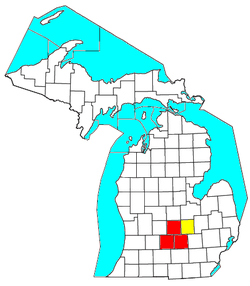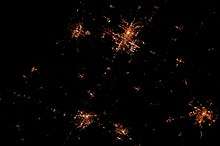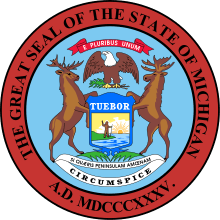Lansing–East Lansing metropolitan area
The Lansing–East Lansing Metropolitan Statistical Area is a three-county metropolitan area located in Central Michigan defined by the Office of Management and Budget, and encompassing the counties of Eaton, Clinton, and Ingham. The region is colloquially referred to as "Mid" or Central Michigan, and less often as "Greater Lansing". As of the 2010 census, the MSA had a population of 464,036. It ranks as Michigan's third-largest metropolitan area behind metropolitan Detroit and Grand Rapids.
Metro Lansing Lansing–East Lansing MSA Lansing–East Lansing–Owosso CSA | |
|---|---|
Metropolitan Area | |
 Location of the Lansing–East Lansing–Owosso CSA
and its components: Lansing–East Lansing Metropolitan Statistical Area
Owosso Micropolitan Statistical Area | |
| Country | United States |
| State | Michigan |
| Largest city | Lansing |
| Counties | List
|
| Area | |
| • Urban | 158.1 sq mi (409 km2) |
| • MSA | 1,714.6 sq mi (4,441 km2) |
| • CSA | 2,255.6 sq mi (5,842 km2) |
| Elevation | 830-1,050 ft (510 m) |
| Population (2010) | |
| • Urban | 313,532 |
| • MSA | 464,036 |
| • CSA | 534,684 |
| Time zone | UTC-5 (EST) |
| • Summer (DST) | UTC-4 (EDT) |
| Area code(s) | 517, 989 |
The metropolitan area was originally defined as only including Ingham County in 1950, but Eaton and Clinton counties were added in 1960. Ionia County was added in 1973, but taken out a decade later for the 1990 Census.[1]
The Lansing–East Lansing–Owosso Combined Statistical Area includes the Lansing–East Lansing MSA, plus the Owosso μSA, which includes Shiawassee County. As of the 2010 census, the CSA had a population of 534,684.
The Lansing Urban Area, as defined by the U.S. Census Bureau, which measures the extent of the built environment, had a population of 313,532 as of the 2010 census.
Counties
Lansing–East Lansing MSA
Owosso μSA
Communities

Cities and Townships with more than 25,000 inhabitants
- Lansing (Principal City)
- East Lansing (Principal City)
- Meridian Charter Township
- Delta Charter Township
- Delhi Charter Township
Cities and Townships with 10,000 to 25,000 inhabitants
Demographics
| Historical population | |||
|---|---|---|---|
| Census | Pop. | %± | |
| 1900 | 96,622 | — | |
| 1910 | 106,938 | 10.7% | |
| 1920 | 134,041 | 25.3% | |
| 1930 | 172,489 | 28.7% | |
| 1940 | 191,411 | 11.0% | |
| 1950 | 244,159 | 27.6% | |
| 1960 | 298,949 | 22.4% | |
| 1970 | 378,423 | 26.6% | |
| 1980 | 416,667 | 10.1% | |
| 1990 | 432,674 | 3.8% | |
| 2000 | 447,734 | 3.5% | |
| 2010 | 464,036 | 3.6% | |
| Est. 2019 | 550,391 | 18.6% | |
As of the census[2] of 2010, there were 464,036 people, 183,442 households, and 112,131 families residing within the MSA. The racial makeup of the MSA was 81.6% White, 8.9% African American, 0.5% Native American, 3.8% Asian, 0.03% Pacific Islander, 1.9% from other races, and 3.3% from two or more races. Hispanic or Latino of any race were 3.9% of the population.
As of the 2010 American Community Survey estimates, the median income for a household in the MSA was $47,731, and the median income for a family was $60,602. The per capita income for the MSA was $23,359. The region's foreign-born population sat at 7.0%.
See also
- Michigan census statistical areas

